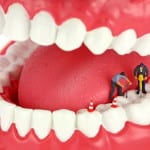 Root canal treatment is a much maligned treatment, but the truth of the matter is that this procedure can save your teeth. Many people are fearful of root canal therapy because they assume that it’s going to be painful, but treatment is carried out under local anaesthetic, so you won’t feel any pain.
Root canal treatment is a much maligned treatment, but the truth of the matter is that this procedure can save your teeth. Many people are fearful of root canal therapy because they assume that it’s going to be painful, but treatment is carried out under local anaesthetic, so you won’t feel any pain.
What is root canal treatment?
Root canal treatment is a procedure, which is used to treat infected and damaged teeth. The aim of the procedure is to remove decayed or damaged tissue from the tooth once the pulp has been infected. The pulp is the tooth’s living tissue and once it is damaged, the tooth starts to die, as blood flow is reduced. At this stage, there’s a risk of infection spreading further, and the tooth will eventually become rotten. To avoid extraction, your dentist may recommend root canal treatment.
What does root canal treatment involve?
Before your dentist starts the procedure, they will numb the tooth to prevent you from feeling any pain. Once the anaesthetic has taken effect, your dentist will drill into the tooth to access the root canals. Any decayed or damaged pulp tissue will be removed, and the canals will be cleaned and then stuffed with material known as gutta percha. This seals the root canals and reduces the risk of further infection.
After root canal treatment, your dentist may recommend placing a new crown on the tooth to make it stronger and more resistant to damage. Initially, a temporary crown may be used, and this will be replaced by a permanent crown around 2 weeks later. We can use ceramics to make the crown, so you won’t be able to tell the difference between the crown and the rest of the natural tooth structure.
If you’re nervous about having root canal treatment or you’d like to find out more about the procedure and how it could benefit you, our dental team will be happy to help.







 When is a hopeless tooth considered to be a hopeless? You would have thought the answer would be obvious. It’s in the title- hopeless. But as any dentist in Leeds will tell you, it isn’t that easy a decision to make. 50 years ago, the decision to remove a tooth was a lot easier. Now however, with modern techniques and treatments, a dentist would rather pull out all the stops, than pull out the tooth. Generally, there are two major factors to consider before rendering a tooth a lost cause- restorability and periodontal support. Modern advances in treatments make most teeth restorable. Most endodontic techniques can restore a damaged or decayed tooth. By using root canal treatment, the affected tooth can be can be saved by the removal of the roots, dead tissue and nerves and then having the hole cleaned and filled, before deciding whether to cap the tooth. This will restore function. But what runs deeper at this point is just how much damage has been caused to the surrounding area by the damage or the decay to the tooth. Periodontic diagnosis of the area around the tooth relies on how advanced the disease has become. It will rely on the pocket depth between the tooth and gum, the decay in the bone supporting the tooth, the level of mobility in the tooth and the crown to root ratio. And before rendering the tooth hopeless, there are two final factors to consider before the tooth is condemned. The rate of progression of periodontal disease and the age of the patient- the older the patient, the more likely the tooth will be removed.
When is a hopeless tooth considered to be a hopeless? You would have thought the answer would be obvious. It’s in the title- hopeless. But as any dentist in Leeds will tell you, it isn’t that easy a decision to make. 50 years ago, the decision to remove a tooth was a lot easier. Now however, with modern techniques and treatments, a dentist would rather pull out all the stops, than pull out the tooth. Generally, there are two major factors to consider before rendering a tooth a lost cause- restorability and periodontal support. Modern advances in treatments make most teeth restorable. Most endodontic techniques can restore a damaged or decayed tooth. By using root canal treatment, the affected tooth can be can be saved by the removal of the roots, dead tissue and nerves and then having the hole cleaned and filled, before deciding whether to cap the tooth. This will restore function. But what runs deeper at this point is just how much damage has been caused to the surrounding area by the damage or the decay to the tooth. Periodontic diagnosis of the area around the tooth relies on how advanced the disease has become. It will rely on the pocket depth between the tooth and gum, the decay in the bone supporting the tooth, the level of mobility in the tooth and the crown to root ratio. And before rendering the tooth hopeless, there are two final factors to consider before the tooth is condemned. The rate of progression of periodontal disease and the age of the patient- the older the patient, the more likely the tooth will be removed. A root canal therapy is also known as endodontics and is done when the tooth pulp gets decayed or infected. The pulp of a tooth is its blood and nerve supply and hence when this gets infected, it can lead to many other serious oral problems if left untreated. The infection can spread to other healthy teeth or cause abscess in the surrounding region. Hence it is best to get a root canal treatment done in the City of Leeds to keep your teeth in top health.
A root canal therapy is also known as endodontics and is done when the tooth pulp gets decayed or infected. The pulp of a tooth is its blood and nerve supply and hence when this gets infected, it can lead to many other serious oral problems if left untreated. The infection can spread to other healthy teeth or cause abscess in the surrounding region. Hence it is best to get a root canal treatment done in the City of Leeds to keep your teeth in top health.

